image: Paul Stevenson, from flickr, Creative Commons CC BY 2.0
When the members of the non-profit Group Pattern Language Project developed the 91-card Group Works deck [download 1-page summary of all 91 patterns; download a deck free; buy a professionally printed deck], we intended it mainly to help facilitators and participants in meetings and other deliberative work to use their time more effectively and to improve their collaborative processes. But we’ve discovered that this Pattern Language is being applied by some of the 2000+ people and organizations using it in ways we had never imagined. Many of these creative applications can help people work smarter, more effectively and more joyfully, and show their “best stuff,” and not just in a meeting context. Here are ten of them:
1. Unearth Your Organization’s Shared Values (and those you share with the people using your products and services)
image: chart from City of Calgary Cultural Transformation Project Dream Phase 2013 draft report
The City of Calgary consulted with a large proportion of their workers, and with a group of the City’s citizens, and used the 91 pattern cards to identify the top 7 Shared Values of each group (they’re illustrated above). Remarkably, 6 of them were the same. The exercise brought into sharp focus what was most important to both groups, and provided the impetus to assess actions that would help the City’s workers improve the quality and value of their services, and improve the processes they use throughout the organization.
What are your people’s shared values? Do the people who use your products and services share them?
2. Create “Spaces” Big (and Safe) Enough to Encourage Candour, Trust and Boldness
Chris Corrigan, one of the many facilitators who helped develop the Pattern Language of group process, is using the cards all over the world to support his Art of Hosting practice of holding space — creating a generative and safe ‘container’ within which people can be honest, creative, and courageous. In his book The Tao of Holding Space he writes:
“[The space is] the ground in which structure organizes the support and growth of action from ideas. From that empty place, small invitations emerge. From the small invitations, conversation nurtures growth. From that growth comes the momentum that attracts the resources of time and attention and money to see the ideas to completion. The emptier the space the more giving it is and the more intricate the action that emerges. There is no need to talk about it, because that only confuses things. Just offer it and hold it open.”
Do you create such spaces for your people? Do you know how to “hold them open”?
3. Help Your People Appreciate and Embrace Complexity and Emergence
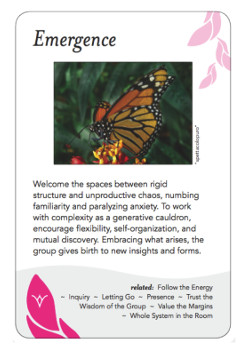
Gibran Rivera of the Boston-based Barr Fellowship community describes the importance of tapping into “the power of authentic relationship and a trust in the organic power of emergence. Emergence is not implementable, a fact that seriously challenges our dominant (and industrial) paradigm for change. We don’t ‘do’ emergence, we create conditions for emergence so that emergence can happen all by itself.”
In complex systems sustained change is predominantly something that emerges, rather than something that can be designed and imposed top-down. The Pattern Language provides a vocabulary for exploring and discussing the complexity of issues and recognizing and enabling emergent possibilities as they arise.
Do you know how complex emergent systems differ from merely complicated mechanistic ones? Do your programs, plans and projects appreciate this difference?
4. Elicit Your Quieter Members’ Important Stories

All of us have valuable information, insights and perspectives that can improve decision-making, collaboration and work effectiveness, but not everyone is articulate and forthright at conveying them. Stories provide a context-rich vehicle by which people, when asked in genuine curiosity, can explain how ‘their’ world really works, so that others can make sense of it at a deep and actionable level.
The City of Calgary used a ‘story’ process, with the Pattern Language cards as its framework, to interview its people across all its service areas, from roads and bridges to regulations, parks and recycling. The story format allowed people not used to being asked about their work and its issues to talk about them easily. One employee in the roads department, for example, told a story about how astonished and delighted he was when the new administrative head of the department took off his tie and spent a day in the field learning how to lay cement.
Such stories have immense power. How many of them in your organization remain unheard?
5. Facilitate Conversations That Matter
The Pattern Language we’re using was designed for group deliberative activities, and an important subset of such activities are conversations. My experience as a Knowledge Officer for a large organization taught me that information, ideas, insights and perspectives are best conveyed through context-rich, iterative conversations among people with shared passion and mutual trust. But most of us are not very skilled at conversation, for all the practice we have at it. The Group Works Pattern Language provides a vehicle for self-assessing, self-monitoring and practicing these skills. When we are preparing for an important conversation, or reflecting on one that went especially well (or badly), we use the cards to “storyboard” the conversation. Gradually, we’re learning the qualities of great conversations and invoking them at every opportunity.
How skilled are you and your colleagues at the art of conversation?
6. Enable Your People to Identify Their Gifts and Follow Their Passions
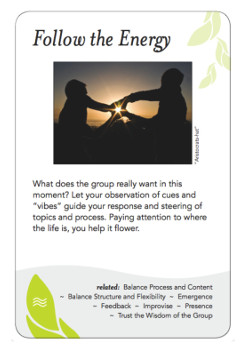
I wrote in my book Finding the Sweet Spot the importance of discovering the work that lies at the intersection of what you do uniquely well, what you love to do, and what’s needed in the world. As part of their process, the City of Calgary asked their people to identify the Patterns and qualities that made (or would make) the City a great workplace. This Appreciative Inquiry approach inevitably helped their people identify what they love, and care about, in their work, and the degree to which they are working in their “sweet spot”. And nothing can make people shine more than an appreciation of what they care about and do well, and the opportunity to do more of it.
Do you know your own “sweet spot”? Are you working in it?
7. Say “Thank You” in a Remarkable and Memorable Way
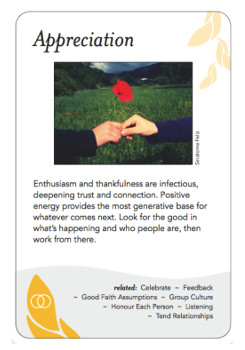
There is an iPhone app of the Pattern Language (and an Android app is in the works), but some people have been using images of the cards online to “speak” with others familiar with the Language in more novel ways. One that has been particularly appreciated is, after a meeting or conversation or event in which someone has exemplified one of the Patterns, sending them an e-mail with an image of that Pattern card and a short accompanying thank-you note saying something like “This is a personal ‘thank you’ for having recently exemplified the ____ pattern of excellent group process by ___”.
It’s a unique and quick way to specifically recognize and reward outstanding group process work (whether as facilitator or participant), and recipients are often so taken with this gesture that they take the first opportunity to ‘pay it forward’ by sending a similar note to the next person they notice doing exceptional work. There’s a free zip file of all 91 Pattern card images you can download, that makes this easy to do.
Who is demonstrating excellent group process in your organization? Do they know it’s appreciated?
8. Empower Your People to Co-Organize and Co-Facilitate Effectively
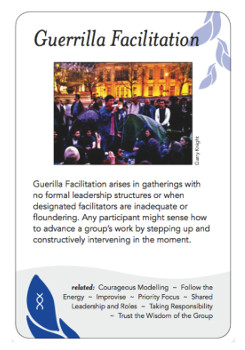
In most organizations, management calls the meetings and sets up the task groups. By teaching your people the Pattern Language of exemplary group process, you give them the knowledge and tools to self-organize well designed and highly effective get-togethers, peer to peer. And you give them the skill to intervene effectively in any deliberative activity that is not being well facilitated, or is not being facilitated at all (but should be), and in the process improving its effectiveness and value. That’s a skill sure to be appreciated by anyone who’s suffered through horrible meetings.
How well-facilitated are your meetings and deliberative and collaborative activities? Could a workforce of skilled “guerrilla facilitators” make them more productive?
9. Learn, and Teach Your People, a Shared “Appreciative” Language
All of the 91 Patterns we decided upon are framed appreciatively — they are things that have been shown, over and over, to just work, at many scales and in many contexts. We deliberately avoided “anti-patterns” and found, finally, that they weren’t really needed, or particularly helpful. We all know the ingredients of poor group process.
Those who have, either within their organizations or as part of facilitator communities of practice, had the opportunity to learn the Patterns are now speaking to each other in this amazing shared Pattern Language. When they say to each other “Follow the Energy” or “Not About You” (two of the Pattern names) they immediately know what that means, and have ideas for how to apply it. It’s a wonderful shorthand of shared understanding and experience, and a powerful way to learn, internalize and institutionalize better group process.
How many of the 91 Patterns are part of the “language” of your organization?
10. Re-envision Your Organization’s Essential “Gestalt”
image: Gene Stull
Permaculture teacher Delvin Solkinson has been using the Pattern Language of group process for three years as part of his permaculture design courses (the photo above shows all 91 cards in a spiral, and was taken at a recent course at the home of visionary artists Alex and Allyson Grey in New York). The purpose of the courses is nothing less than “to learn to map and design our land and our lives.” What Delvin calls “pattern literacy” is a powerful means to appreciate and articulate “why we’re here” — our entire purpose and the gestalt, the essential quality, of our community or our organization.
What are the Patterns that differentiate your organization powerfully from other organizations performing similar functions? What are the Patterns that make your community’s members a true community, one whose members care about each other?
~~~~~
What we’re starting to realize is that life is substantially a “group process,” and that tools that help us recognize and invoke the patterns of exemplary group process can help us in much broader ways than just meetings. They can help us, and the people we live and work with, do many things better: In a word, they can help us shine.


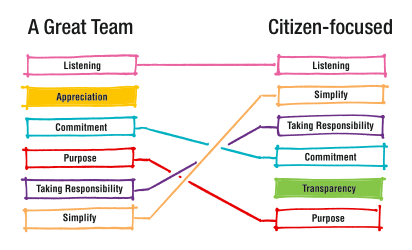
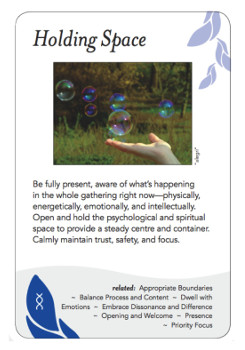
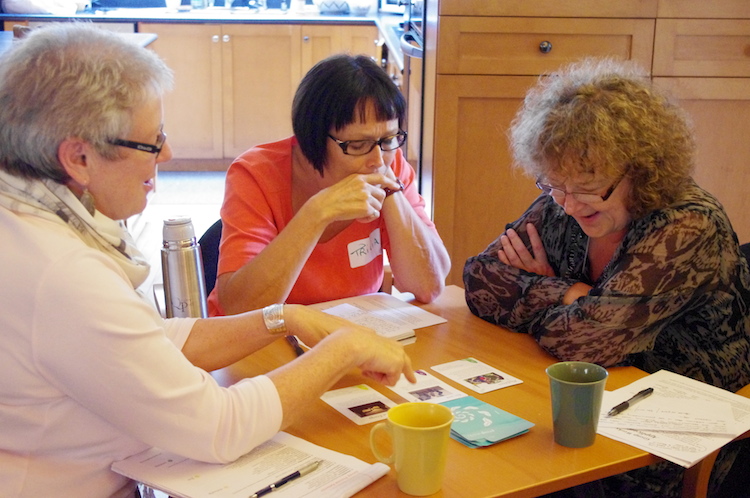

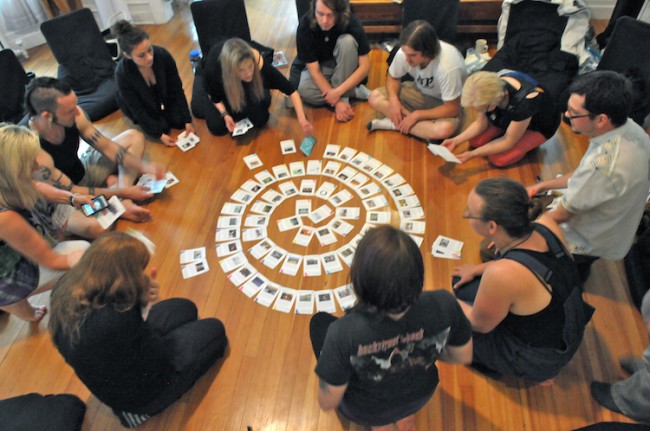




Great…! Some time ago, in one of your posts, you published a similar cards game? Thanks a lot…!
Love all these examples – inspiring possibilities!
Many thanks for the writing and sharing.
Amanda